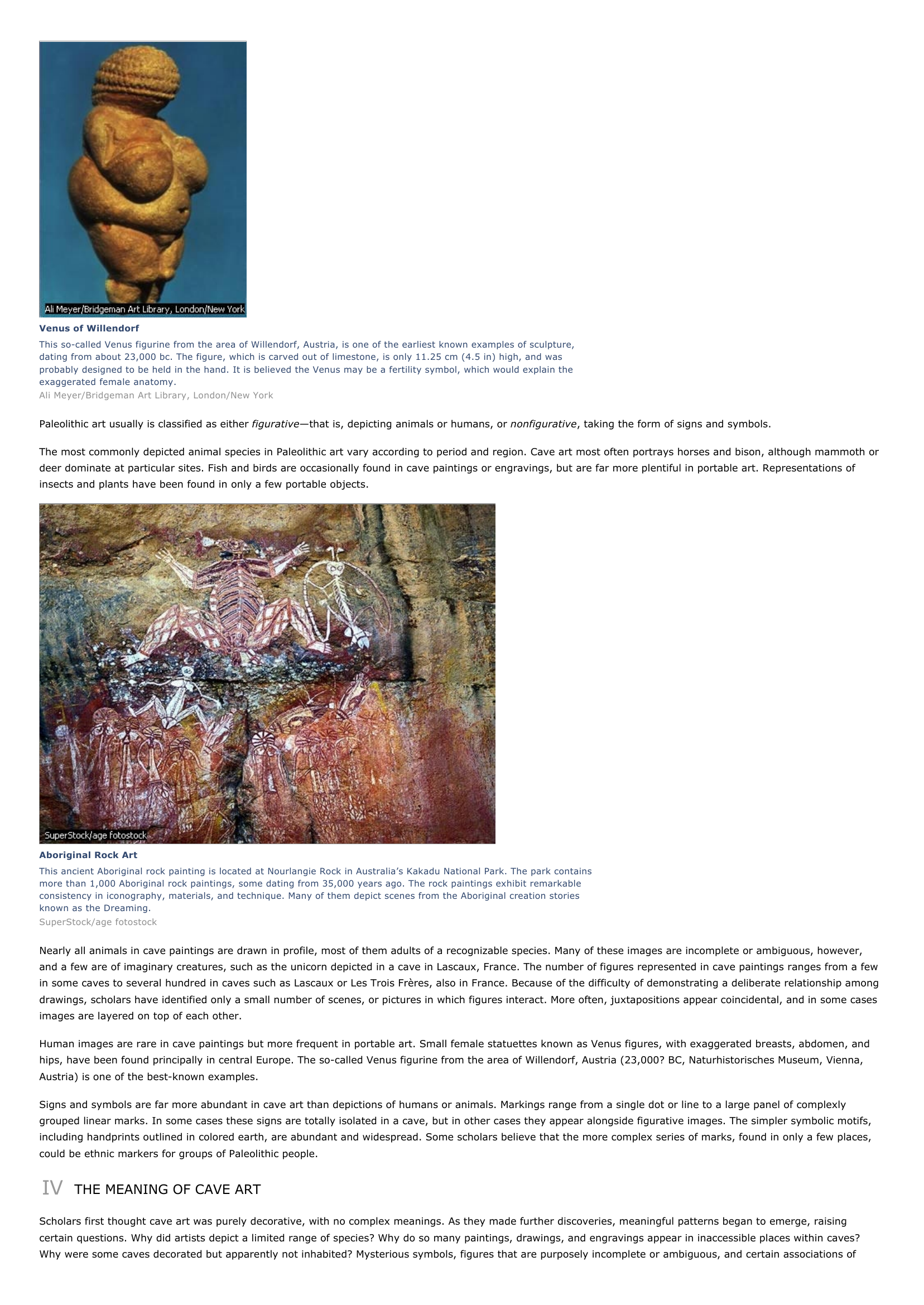Paleolithic Art I INTRODUCTION Cave Painting, Lascaux This portion of a cave painting in what is now Lascaux, France, was done by Paleolithic artists about 13,000 bc.
Publié le 12/05/2013

Extrait du document


«
Venus of WillendorfThis so-called Venus figurine from the area of Willendorf, Austria, is one of the earliest known examples of sculpture,dating from about 23,000 bc.
The figure, which is carved out of limestone, is only 11.25 cm (4.5 in) high, and wasprobably designed to be held in the hand.
It is believed the Venus may be a fertility symbol, which would explain theexaggerated female anatomy.Ali Meyer/Bridgeman Art Library, London/New York
Paleolithic art usually is classified as either figurative —that is, depicting animals or humans, or nonfigurative , taking the form of signs and symbols.
The most commonly depicted animal species in Paleolithic art vary according to period and region.
Cave art most often portrays horses and bison, although mammoth ordeer dominate at particular sites.
Fish and birds are occasionally found in cave paintings or engravings, but are far more plentiful in portable art.
Representations ofinsects and plants have been found in only a few portable objects.
Aboriginal Rock ArtThis ancient Aboriginal rock painting is located at Nourlangie Rock in Australia’s Kakadu National Park.
The park containsmore than 1,000 Aboriginal rock paintings, some dating from 35,000 years ago.
The rock paintings exhibit remarkableconsistency in iconography, materials, and technique.
Many of them depict scenes from the Aboriginal creation storiesknown as the Dreaming.SuperStock/age fotostock
Nearly all animals in cave paintings are drawn in profile, most of them adults of a recognizable species.
Many of these images are incomplete or ambiguous, however,and a few are of imaginary creatures, such as the unicorn depicted in a cave in Lascaux, France.
The number of figures represented in cave paintings ranges from a fewin some caves to several hundred in caves such as Lascaux or Les Trois Frères, also in France.
Because of the difficulty of demonstrating a deliberate relationship amongdrawings, scholars have identified only a small number of scenes, or pictures in which figures interact.
More often, juxtapositions appear coincidental, and in some casesimages are layered on top of each other.
Human images are rare in cave paintings but more frequent in portable art.
Small female statuettes known as Venus figures, with exaggerated breasts, abdomen, andhips, have been found principally in central Europe.
The so-called Venus figurine from the area of Willendorf, Austria (23,000? BC, Naturhistorisches Museum, Vienna,Austria) is one of the best-known examples.
Signs and symbols are far more abundant in cave art than depictions of humans or animals.
Markings range from a single dot or line to a large panel of complexlygrouped linear marks.
In some cases these signs are totally isolated in a cave, but in other cases they appear alongside figurative images.
The simpler symbolic motifs,including handprints outlined in colored earth, are abundant and widespread.
Some scholars believe that the more complex series of marks, found in only a few places,could be ethnic markers for groups of Paleolithic people.
IV THE MEANING OF CAVE ART
Scholars first thought cave art was purely decorative, with no complex meanings.
As they made further discoveries, meaningful patterns began to emerge, raisingcertain questions.
Why did artists depict a limited range of species? Why do so many paintings, drawings, and engravings appear in inaccessible places within caves?Why were some caves decorated but apparently not inhabited? Mysterious symbols, figures that are purposely incomplete or ambiguous, and certain associations of.
»
↓↓↓ APERÇU DU DOCUMENT ↓↓↓
Liens utiles
- Folk Art I INTRODUCTION Carved Native American Figure This figure of a Native American trapper was carved from a single pine log (about 1850-1890).
- Islamic Art and Architecture I INTRODUCTION Córdoba Mosque Courtyard This mosque and courtyard with its repeated horseshoe arches was built between the 8th and 10th centuries in Córdoba, Spain.
- Latin American Painting I INTRODUCTION Diego Rivera Museum Gallery The studio of Mexican painter Diego Rivera is now maintained as an art museum in Mexico City.
- The Teachings of Muhammad During the early 7th century, a trader named Muhammad was meditating in a cave near Mecca in what is now Saudi Arabia, when he experienced a vision of the archangel Gabriel who declared Muhammad to be a prophet of God.
- Art Nouveau I INTRODUCTION Detail of Art Nouveau Decoration This detail of a door decoration from a building constructed in the early 20th century in Milan, Italy, illustrates the stylistic themes associated with art nouveau.





















